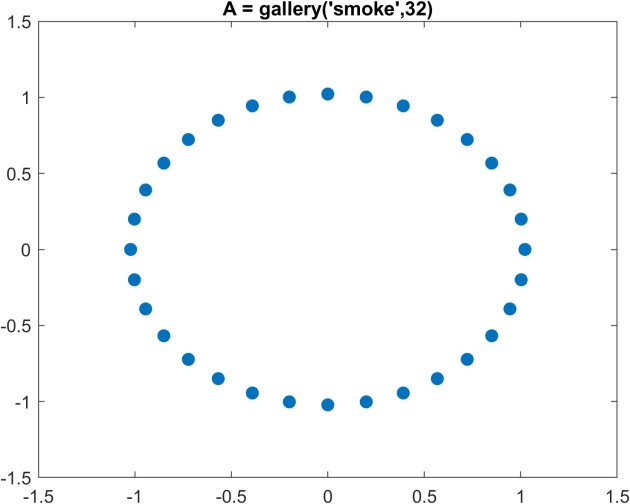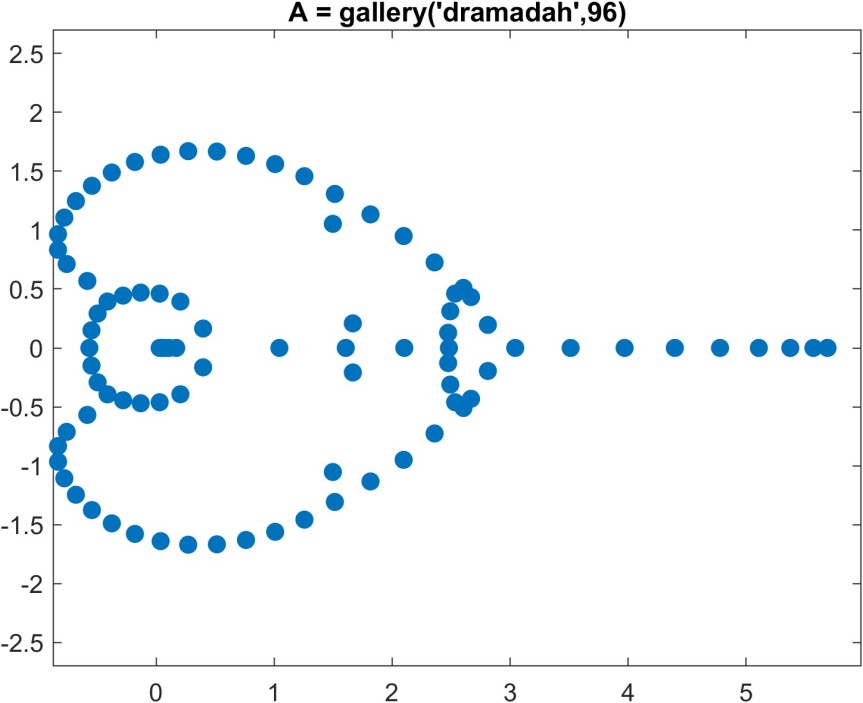An eigenvalue of a square matrix is a scalar
such that
for some nonzero vector
. The vector
is an eigenvector of
and it has the distinction of being a direction that is not changed on multiplication by
.
An matrix has
eigenvalues. This can be seen by noting that
is equivalent to
, which means that
is singular, since
. Hence
. But
is a scalar polynomial of degree (the characteristic polynomial of
) with nonzero leading coefficient and so has
roots, which are the eigenvalues of
. Since
, the eigenvalues of
are the same as those of
.
A real matrix may have complex eigenvalues, but they appear in complex conjugate pairs. Indeed implies
, so if
is real then
is an eigenvalue of
with eigenvector
.
Here are some matrices and their eigenvalues.
Note that and
are upper triangular, that is,
for
. For such a matrix the eigenvalues are the diagonal elements.
A symmetric matrix () or Hermitian matrix (
, where
) has real eigenvalues. A proof is
so premultiplying the first equation by
and postmultiplying the second by
gives
and
, which means that
, or
since
. The matrix
above is symmetric.
A skew-symmetric matrix () or skew-Hermitian complex matrix (
) has pure imaginary eigenvalues. A proof is similar to the Hermitian case:
and so
is equal to both
and
, so
. The matrix
above is skew-symmetric.
In general, the eigenvalues of a matrix can lie anywhere in the complex plane, subject to restrictions based on matrix structure such as symmetry or skew-symmetry, but they are restricted to the disc centered at the origin with radius
, because for any matrix norm
it can be shown that every eigenvalue satisfies
.
Here are some example eigenvalue distributions, computed in MATLAB. (The eigenvalues are computed at high precision using the Advanpix Multiprecision Computing Toolbox in order to ensure that rounding errors do not affect the plots.) The second and third matrices are real, so the eigenvalues are symmetrically distributed about the real axis. (The first matrix is complex.)



Although this article is about eigenvalues we need to say a little more about eigenvectors. An matrix
with distinct eigenvalues has
linearly independent eigenvectors. Indeed it is diagonalizable:
for some nonsingular matrix
with
the matrix of eigenvalues. If we write
in terms of its columns as
then
is equivalent to
,
, so the
are eigenvectors of
. The matrices
and
above both have two linearly independent eigenvectors.
If there are repeated eigenvalues there can be less than linearly independent eigenvectors. The matrix
above has only one eigenvector: the vector
(or any nonzero scalar multiple of it). This matrix is a Jordan block. The matrix
shows that a matrix with repeated eigenvalues can have linearly independent eigenvectors.
Here are some questions about eigenvalues.
- What matrix decompositions reveal eigenvalues? The answer is the Jordan canonical form and the Schur decomposition. The Jordan canonical form shows how many linearly independent eigenvectors are associated with each eigenvalue.
- Can we obtain better bounds on where eigenvalues lie in the complex plane? Many results are available, of which the most well-known is Gershgorin’s theorem.
- How can we compute eigenvalues? Various methods are available. The QR algorithm is widely used and is applicable to all types of eigenvalue problems.
Finally, we note that the concept of eigenvalue is more general than just for matrices: it extends to nonlinear operators on finite or infinite dimensional spaces.
References
Many books include treatments of eigenvalues of matrices. We give just three examples.
- Gene Golub and Charles F. Van Loan, Matrix Computations, fourth edition, Johns Hopkins University Press, Baltimore, MD, USA, 2013.
- Roger A. Horn and Charles R. Johnson, Matrix Analysis, second edition, Cambridge University Press, 2013. My review of the second edition.
- Carl D. Meyer, Matrix Analysis and Applied Linear Algebra, Society for Industrial and Applied Mathematics, Philadelphia, PA, USA, 2000.
Related Blog Posts
This article is part of the “What Is” series, available from https://nhigham.com/category/what-is and in PDF form from the GitHub repository https://github.com/higham/what-is.
